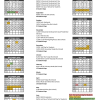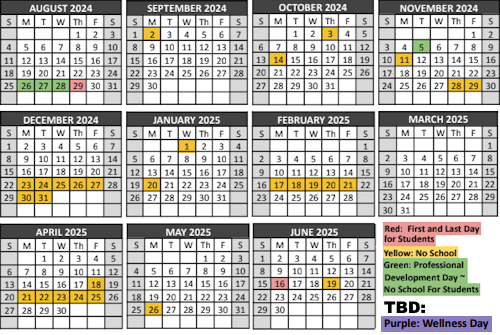Above: The school committees voted to approve a calendar for ’24-’25 that follows the same format as this year’s. But the “Wellness Days” are still up in the air. (images edited from draft calendar in meeting packet)
On Wednesday night, Superintendent Gregory Martineau told the school committees of Northborough, Southborough, and the regional high school that he wants to work with teachers, students, and the community before recommending when to use Wellness Days next year.
He noted that aligning them with religious holidays next year “might not be the best option for us to consider”.
The challenge is that high school students and teachers recommend spreading them throughout the year to reduce negative impacts. But most of the holidays they were meant to help avoid conflicts with are in the fall.
I think it’s worth pointing out that the frequency of other school interruptions during the same time frame adds to the challenge. (Scroll down for more on that.)
Looking forward, Martineau plans to put together another study group for working on the 2025-2026 calendar. He didn’t specify how he will work through the issue for next year’s Wellness Days. (He may provide more information on that publicly soon. He plans to announce the new calendar in his next newsletter to the community on Tuesday.)
For those not familiar, Wellness Days are days that school is in session, but no tests, quizzes, or homework is to be assigned. The intent was to avoid students having to choose between achieving good grades and honoring their religion on significant holidays. (You can read more here.)
There was an additional hope that the work breaks would help “overall well being” for the entire student population.
Martineau explained to school committee members that the Wellness Days inadvertently caused issues and extra stress for Algonquin students. Students complained that the forced breaks led to work that piled up, with a larger workload immediately following the breaks.
Regional School Committee member John Wysocki referred to the summary of the survey results. He noted that students complained about inconsistency of how teachers utilized the days. He wondered if more education was needed for teachers.
Martineau confirmed that some student feedback was that in many instances, teachers weren’t following the intent of the days. But he highlighted that the condensed timeframe for when the days fell made it hard for teachers to move the curriculum forward.
Regional member Karen Ares suggested that it might be time to take another look at the homework policy. She noted that their high school representative is constantly talking about stress. Member Kathleen Howland agreed and member Joan Frank suggested it was a good topic for the Policy Subcommittee.
 The committees unanimously adopted the calendar, which reflects the same format as this year’s.
The committees unanimously adopted the calendar, which reflects the same format as this year’s.
Before voting, members discussed the Professional Development Days schedule. Three of them are front loaded to the start of the year based on the teachers’ preference. Southborough Committee member Kamali O’Meally said educators liked the combined time prior to school starting.
One additional, PD day takes place in November, when the schools are opened up to the public for voting in the presidential election. Teachers are also allowed some flexible hours for self-directed Professional Development. (You can read more about that concept piloted in 2018 here.)
Fall Interruptions
While Martineau stressed that most of the Wellness Days were in a condensed period, they also fell at a time with a number of other interruptions to the school calendar.
Below is a list of the religious holidays, state holidays, and other interruptions/obstacles in the first three months of the school calendar:
- Labor Day (Federal Holiday)
- Rosh Hashanah (Jewish Holiday – Sept/Oct, sometimes falls on weekend)
- Yom Kippur (Jewish Holiday – Sept/Oct, sometimes falls on weekend)
- Columbus Day (State Holiday)
- Halloween (It was a Wellness Day this year, presumable to allow trick-or-treaters to have fun)
- Diwali (Hindu Holiday – Oct/Nov, sometimes falls on weekend)
- Presidential/State Election Day (Schools are used for voting)
- Veterans Day (Federal Holiday)
- Thanksgiving Recess (2 ½ Day break)
Survey Results
Earlier this week, I shared Martineau’s summary of community feedback through Wellness Days surveys. The packet for this week’s meeting also included graphs with more detailed data on the responses to the public survey.
More than 80% of the participants were parents of students currently in the schools. 19% were district faculty or staff. Only 8 respondents listed themselves as neither.
 328 community participants rated their support for having Wellness Days in Calendar. Only 14% selected Not Supportive (1 or 2 on scale from 1-6), 64% voted Very Supportive (5 or 6), while the remainder were more neutral (3 or 4)
328 community participants rated their support for having Wellness Days in Calendar. Only 14% selected Not Supportive (1 or 2 on scale from 1-6), 64% voted Very Supportive (5 or 6), while the remainder were more neutral (3 or 4)
 In terms of the impact of those days, only 14% of 330 said there were negative impacts (1 or 2 on scale from 1-5). 50% rated the Impact as positive. 35.5% were neutral.
In terms of the impact of those days, only 14% of 330 said there were negative impacts (1 or 2 on scale from 1-5). 50% rated the Impact as positive. 35.5% were neutral.
The detailed data for the ARHS student survey wasn’t included.


